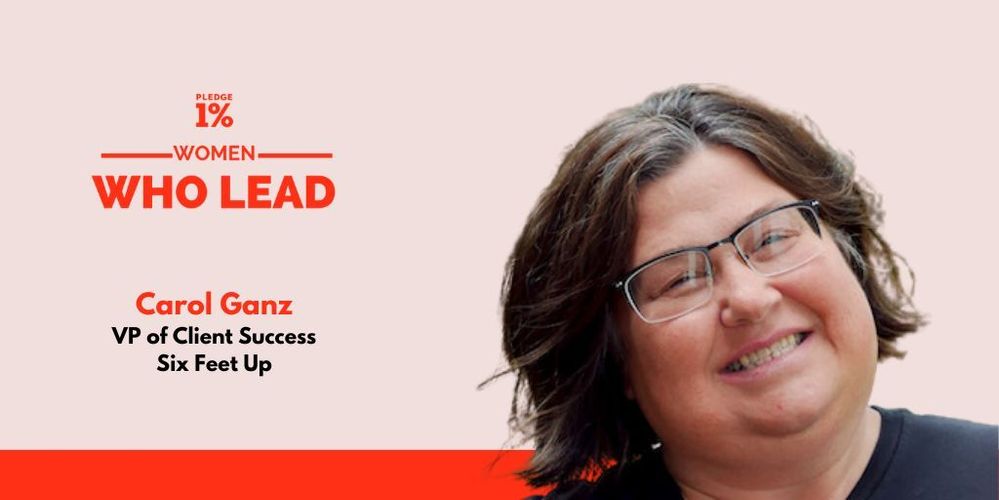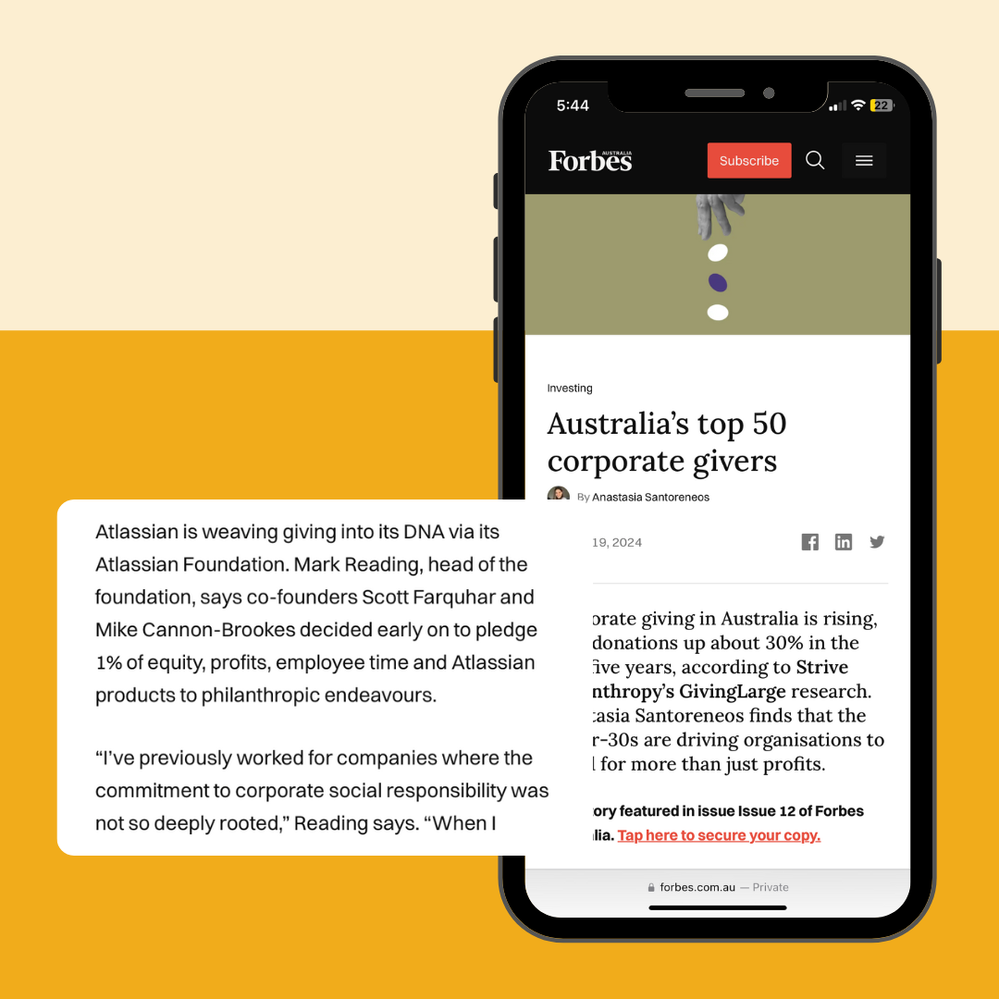
Original article here
Author: Anastasia Santoreneos
The top 50 corporate givers in Australia contributed close to $1.5 billion to the nation’s community in 2023, thanks to large donations from companies like BHP, Coles, Rio Tinto and Woolworths. But philanthropy – whilst beneficial for the community – is quickly becoming a strategic choice.
Strive Philanthropy’s 2023 GivingLarge report, updated this year to reflect the latest earnings, shows corporate giving amongst the most prolific givers has increased about 30% in five years (from $1.1 billion). The data shows that across 2023, BHP donated the most at $222,156,222 to causes like decarbonisation, thriving communities, responsible supply chains and Indigenous communities. Coles came just under with $151,858,928. In terms of industries, contributions to the community are increasing from mining and resource companies, retailers, banks, and tech companies.
But chunky individual donations tell half the story, Strive Philanthropy director and co-founder Jarrod Miles says, with contributions as a percentage of profit filling in the rest. Across 2023, it was the eco-friendly toilet paper brand, Who Gives A Crap that took the cake, donating 50% of profits to water sanitation, in line with its ethos. Coles came in second at 9.03%.
“Converting dollar values into relative percentages of company profits is a useful way to enable robust comparisons and arguably provides a more meaningful review of company generosity,” Miles says.
But what’s driving the upward trend in giving? In a recent survey of BHP’s workforce, 91% of respondents said working for a company offering a workplace-giving program was important.
“When it comes to attracting and retaining a talented and skilled workforce, we know we need to ensure BHP is a rewarding place to work,” BHP President Geraldine Slattery says. “Part of this is giving our people a say in where social investment is directed and facilitating employees to support causes important to them.”
Miles says it’s the perfect storm of corporations and consumers becoming more ESG-conscious, shareholders becoming more impact-driven, and employees looking for purpose.
“The planets have certainly aligned with these social trends, which is leading to a firming in the value they may bring to the business,” Miles says. “Enlightened companies are taking the opportunity to develop strategies for these emerging stakeholder needs and are quickly realising that their increased community investment can coincide or even boost their firm’s success.”
That’s echoed by Philanthropy Australia CEO Maree Sidey, who says the under-30 demographic drives the organisations they work for to stand for more than profit.
“It comes from that purpose agenda,” Sidey says. “If you are looking at that under-30 generation, they are looking for their purpose to be beyond work – they want their work-life to align with their passions and interests. They want their workplace to engage with social and environmental issues. It needs to be much more integrated, while the over-60s are generally happy to have their charitable interests separate from their work-life.”
“Lots of investors understand the super-power that comes from having purpose at the core of a business – when done right, it’s incredibly motivating for both customers and the team, which can lead to great business outcomes.”
– Simon Griffiths, co-founder, Who Gives A Crap
Atlassian is weaving giving into its DNA via its Atlassian Foundation. Mark Reading, head of the foundation, says co-founders Scott Farquhar and Mike Cannon-Brookes decided early on to pledge 1% of equity, profits, employee time and Atlassian products to philanthropic endeavours.
“I’ve previously worked for companies where the commitment to corporate social responsibility was not so deeply rooted,” Reading says. “When I walked into Atlassian, its view on philanthropy felt completely different. It wasn’t just lip service – giving back felt ingrained in what Atlassian does. This authentic commitment to impact and focusing on the underlying issues rather than the symptoms gives me a real sense of meaning and purpose.”
The company donated $17,077,517 to education in 2023, spread across 16 education changemakers globally, and each employee gets five days of paid leave each year to volunteer. The company also offers a donation-matching program. In 2023, one in four Atlassian employees volunteered as part of a team.
“Atlassians love the Atlassian Foundation,” he says. “We’re regularly told it’s one of the main reasons many people join the company. One of Atlassian’s core values is ‘Be the change you seek’, so the Foundation is a great way for employees to live this value. We empower our people to use their time, talent and tools to make a difference for causes they care about.”
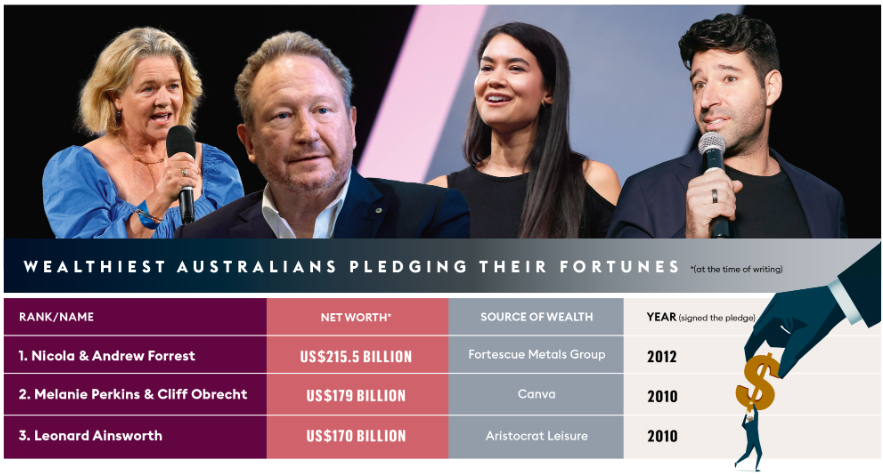
The data also tells another story: that companies in the private sector, like Canva or Who Gives A Crap, are building philanthropy into their brand’s value proposition.
“In true entrepreneurial style, this innovative model has reinvented the relationship between business and philanthropy by placing the firm’s desire to do good in the world right next to their need for financial success,” Miles says.
Who Gives A Crap’s co-founder Simon Griffiths says philanthropy has always been tightly woven into the company’s ethos, and all employees are passionate about their cause (to provide everyone in the world with access to clean water and sanitation).
“It’s the reason we exist,” Griffiths says. “It drives our employees and informs our decisions. It helps that we’re having a lot of fun while doing it, cutting through the doom and gloom with delightful consumer experiences.”
Griffiths points to Dan Pink’s philosophy of motivation, which says that motivation is derived from autonomy, mastery, and purpose.
“We don’t get all three of these things right 100% of the time, but we’re very lucky to have a purpose in spades in our business, so we invest quite a bit of thinking time into how best to connect our team to our purpose,” he says.
And while the business model might seem a little left-field for investors, Who Gives A Crap managed to raise $41.5 million in 2021 to fund its expansion and provide sustainable sanitation solutions to 2 billion people.
“Businesses today have a huge opportunity to go beyond profit and actively contribute to making the world a better place.”
– Robyn King, head of social impact, Canva
“It’s no secret that there has been a huge shift in public markets towards ESG-focused businesses, and that’s not going away,” Griffiths says.
“Lots of investors understand the super-power that comes from having purpose at the core of a business – when done right, it’s incredibly motivating for both customers and the team, which can lead to great business outcomes.
“Not every investor understands this yet, and that’s okay, but the ones that do tend to be all in. They’re less interested in investing in businesses without purpose – they see purpose as a powerful tailwind, or unfair advantage, that will ultimately help them to achieve a stronger return whilst also making the world a better place.”
Canva’s another: with a $31.4 million donation across the 2023 calendar year (more than double its last reported figure), the design juggernaut says its two-step plan drives it. Step One is to build one of the world’s most valuable companies, and Step Two is to do the most good they can.
“Our philanthropic journey has been a lot like building a company,” Canva’s head of social impact, Robyn King, says. “We’ve been on a huge learning journey over the last few years and see this as a lifelong journey to do the most good we can alongside our entire team and user community.”
The company is part of Pledge 1%, and its founders, Cliff Obrecht and Melanie Perkins, are part of Warren Buffett and Bill Gates’ Giving Pledge. The founders have also committed most of their equity (30% of Canva) towards doing good.
“Businesses today have a huge opportunity to go beyond profit and actively contribute to making the world a better place,” King says.
“We want to use our value to drive positive change, and we see this as an integral part of our identity as a company. By doing so, we hope to join other companies paving the way to change the narrative that good for the world and good for business aren’t mutually exclusive.”
And like Atlassian or Who Gives A Crap, Canva believes its philanthropic endeavours align with its employees’ values.
“Our Two-Step plan is one of the key reasons people come to work at Canva and stay,” she says. “It’s a huge driver in attracting incredible talent who resonate with our values and believe in our goals.”
—–
Top 50 corporate givers: Australia
Roughly $1.5 billion was donated last year by Australian companies.
| Rank/Company | Year End (2023) | Community Investment | Causes |
| 1. BHP | June | $222,156,222 | Decarbonisation, indigenous partnerships, responsible supply chains, safe equitable workforce. |
| 2. Coles | June | $161,869,928 | Food rescue, disaster relief, education, health. |
| 3. Rio Tinto | December | $126,429,862 | Community infrastructure, culture and heritage, health & wellbeing. |
| 4. Woolworths | June | $122,076,725 | Food rescue, disaster relief, education, health. |
| 5. Westpac | September | $65,091,056 | Social enterprise, financial inclusion, education, children & young, emergency & crisis relief. |
| 6. Newcrest | June | $64,413,424 | Sustainable cities and community, health and well being. |
| 7. CSL | June | $63,261,063 | Patient communities, innovation and science and local communities. |
| 8. Santos | December | $59,014,148 | Local community, health, education. |
| 9. National Australia Bank | September | $56,000,000 | Emergency relief, environment, social welfare. |
| 10. Commonwealth Bank | June | $53,500,000 | Social and financial wellbeing, disaster relief, indigenous support, education. |
| 11. South32 | June | $41,314,541 | Education and leadership, social wellbeing, economic participation, natural resource resilience. |
| 12. Telstra | June | $40,600,000 | Digital inclusion, environmental action, disadvantaged communities, disaster relief. |
| 13. Macquarie | March | $37,536,000 | Breaking barriers to employment, diversity and equity, inclusion, community sport. |
| 14. Bendigo & Adelaide | June | $32,920,000 | Thriving & healthy communities, disaster relief. |
| 15. Woodside | December | $32,512,030 | Environment, education, employment, and liveability outcomes. |
| 16. ANZ | September | $32,500,000 | Financial wellbeing, housing and environmental sustainability. |
| 17. Canva | June | $31,400,000 | Education, extreme poverty, emergency relief. |
| 18. Wesfarmers | June | $23,700,000 | Medical research and wellbeing, education, arts, disaster relief. |
| 19. Optus | June | $23,529,205 | Educational outcomes, employment opportunities for disadvantaged. |
| 20. Deloitte Australia | June | $18,000,000 | Climate, first nations, food poverty, education, elderly, animal welfare. |
| 21. Ernst & Young Australia | June | $17,500,000 | Youth education, environment, impact entrepreneurs, indigenous, mental health. |
| 22. Atlassian | June | $17,077,517 | Education, capacity building. |
| 23. Mirvac | June | $13,941,632 | Community infrastructure, social enterprise, social connection. |
| 24. OceanaGold | December | $13,719,858 | Local business support, community infrastructure, education, health. |
| 25. KPMG Australia | June | $12,878,834 | Reducing inequalities, climate action, resilient & sustainable communities. |
| 26. QBE Insurance | June | $12,436,280 | Reduced inequality, sustainable cities and communities. |
| 27. PwC Australia | June | $12,400,000 | Disaster and crisis relief, homelessness, NFP capacity. |
| 28. CottonOn | June | $12,337,256 | Education in health, social & public welfare & human rights, mental health and environment. |
| 29. Brambles | June | $11,431,554 | Food security, food waste, environmental restoration, education. |
| 30. Fortescue Metals | June | $10,890,000 | Health and wellness education and development, environmental responsibility, arts and culture. |
| 31. Goodman Group | June | $10,800,000 | Children & youth, community, health, food rescue, environment. |
| 32. Future Generation | June | $10,600,000 | Youth mental health. |
| 33. Hearts and Minds Invest | June | $10,237,269 | Medical research. |
| 34. IAG | June | $10,000,000 | Disaster & community resilience. |
| 35. Colonial Foundation | June | $9,225,000 | Medical research, education to improve inequity, rural & regional vitality. |
| 36. Suncorp | June | $9,043,714 | Financial, social and natural hazard resilience, emergency relief, road safety education. |
| 37. Sargents Pies Foundation | June | $8,000,000 | Children’s hospital care. |
| 38. Sonic | June | $7,800,000 | Reconciliation, employment, emergency relief, medical research. |
| 39. Mineral Resources | June | $7,780,000 | Health & well-being, strengthening local communities, economic empowerment. |
| 40. Stockland | June | $7,718,840 | Accessibility, inclusion, health, education, employment and other bespoke community needs. |
| 41. The Lottery Corporation | June | $7,719,747 | Education, health, social welfare. |
| 42. Nib | June | $6,600,769 | Health, mental health and health equity. |
| 43. Northern Star | June | $6,400,000 | Community, health, environment, indigenous advancement, education & development. |
| 44. GPT Group | June | $6,359,962 | Child wellbeing, youth homelessness and mental health. |
| 45. AGL Energy | June | $4,759,570 | Resilience in communities where we operate, support climate action, energy affordability. |
| 46. Origin Energy | June | $4,500,000 | Family violence, natural disasters, and homelessness. |
| 47. Orica | June | $4,100,000 | Health, education, social & public welfare, environment. |
| 48. Humanitix | December | $4,000,000 | Disadvantaged children, education, healthcare. |
| 49. Transurban | September | $3,800,000 | Empowering customers, championing road safety, strengthening communities. |
| 50. Qantas | June | $3,600,000 | Reconciliation, connecting communities. |
—–
Scale of Generosity
The top ten Australian corporate givers listed by percentage of profits.
| Company / Percentage of Profits | Community Investment | Year End (2023) | Causes |
| Who Gives A Crap – 50.0% | $1,405,617 | June | Water sanitation. |
| Coles – 9.03% | $151,858,928 | June | Food rescue, disaster relief, education, health. |
| OceanaGold – 6.98% | $13,719,588 | December | Local business support, community infrastructure, education, health. |
| Bendigo & Adelaide – 3.38% | $32,900,000 | June | Thriving & healthy communities, disaster relief. |
| Woolworths – 3.03% | $122,076,725 | June | Food rescue, disaster relief, education, health. |
| Newcrest – 3.00% | $64,413,424 | June | Sustainable cities and community, health and well being. |
| Tabcorp – 2.49% | $1,400,000 | June | Emergency relief, health. |
| South32 – 2.08% | $41,134,541 | June | Education and leadership, good health and social wellbeing, economic participation, and natural resource resilience. |
| IAG – 2.04% | $10,000,000 | June | Disaster & community resilience. |
| Orica – 2.02% | $4,100,000 | September | Health, education, social & public welfare, environment. |
Data note: Companies counted only include those that report their earnings/profits. Date = latest data
Are Australian corporates doing enough?
While $1.5 billion is a sizeable figure, GivingLarge notes that the global benchmark for corporate giving is 1%, meaning Australian businesses could be donating a lot more to communities.
“In terms of total corporate community investment, extrapolating the pre-tax profit of Australian businesses each year and applying a 1% calculation, we estimate a potential of up to $5 billion that could make its way from corporate to community each year,” Miles says.
Philanthropy Australia says some may argue that 1% of pre-tax profits isn’t enough either. However, the organisation says it’s focused on helping corporates put more structure behind their giving via their Blueprint to Grow Structured Giving initiative, launched in 2021. That blueprint outlines how philanthropic, for-purpose, business and government sectors can work together to double structured giving by 2030.
A part of that is to raise awareness about corporate giving and help educate corporate founders on best practices.
“It’s got to be done with true intent,” Philanthropy Australia chief Maree Sidey says.
“Compliance and regulatory issues need to be considered at the start of a foundation. It needs the right input, expertise and background. So, I think there’s a real piece of education for corporates that is not just a side hustle; you need to employ the right person, support them, and integrate it fully into the business.”
—–
Billionaires pledging their fortunes

Billionaire philanthropists. Image source: Forbes Australia

Justworks is a technology company that levels the playing field for all small businesses. To formalize their commitment to social impact, Justworks joined the Pledge 1% movement as a Builder in 2021, committing to donating 1% of their assets, including company equity, to the community.
Key to their success has been fostering cross-functional collaboration when designing their impact programs. For example, the social impact team has worked closely with the marketing team on the development and growth of Justworks.org and the Spring Forward Fund. This has allowed for more internal collaboration and has been instrumental in amplifying the mission and vision of these programs.
Justworks also believes in the power of engaging its employees in its grant-making process by inviting team members to review grant applications and vote for the finalists. This enables Justworks to hear diverse voices and perspectives about the projects being pitched, and to get team members across the organization more involved in their social impact program.
Justworks also prioritizes getting feedback from the grantees they support. This helps them iterate and improve their programs to ensure they are maximizing their impact. This includes frequently meeting with grantees and creating spaces to build trust amongst their partners.
Read more about how Justworks is having an impact in their case study below.
Justworks-Case-Study
Original article here
Author: codefortynine GmbH
Since 2019, we are proud to be a member of Pledge 1%. This initiative has inspired us to give back part of our success to the community. What started with 1% has now grown to an impressive 10% of our profits, which we donate each year to charitable causes.
Our Passion for Giving
Our donation practice at codefortynine is more than just an obligation—it’s a passion. The selection of donation recipients is a collective effort: Every employee has the opportunity to present organizations they care about. We then vote together and distribute the donation sum to the chosen organizations. This democratic approach ensures our donations carry a personal touch and reach those who truly need them.
We support various areas, including environmental protection, aiding children and families in need, and promoting open-source projects that enrich our daily work. We are particularly proud of our continuous support for projects dedicated to climate protection. For instance, we offset all our company flight emissions through atmosfair, contributing positively to the reduction of CO₂ and other emissions.
Responding to Global Events
A particularly challenging moment was the outbreak of the war in Ukraine. We immediately initiated donations to support the urgently needed humanitarian aid. This demonstrates how flexible and committed our team is in responding to global events.
“Being part of a company that really cares about making a difference is incredibly rewarding. The democratic approach to selecting donation recipients means that every voice is heard and every cause we support is close to our hearts. It’s inspiring to see how our collective efforts can make a real difference in the world.”
– Markus, Operations Director
Highlighting Special Initiatives
One memorable event was our special raffle at Atlassian Team ’24 in Las Vegas. It enabled the winner to donate $49,000 to an impactful campaign. He chose to donate to UNICEF, helping to support children in need around the world. This event highlights our commitment to making a difference in the world.
Our journey with Pledge 1% has brought us closer together as a company and as a team. We are proud to see the difference our joint efforts can make. We remain committed to our mission and look forward to continuing to make a positive impact on the world through our donations.
A Balanced Approach
At codefortynine, we believe in making a difference both locally and globally. Our donations reflect our commitment to supporting causes that matter in our home country. We are dedicated to contributing to national initiatives that support our local communities and environment, such as the Kinderschutzbund Karlsruhe and the Stiftung THW.
At an international level, our contributions to organizations such as atmosfair and UNICEF ensure that our impact is felt globally. By supporting climate protection initiatives and humanitarian aid measures, we want to tackle global challenges and help people in need worldwide.
Our balanced approach to supporting both national and international causes underscores our dedication to making the world a better place, starting from our own backyard and extending our reach across the globe. Through our thoughtful and democratic donation process, we aim to support a diverse range of initiatives that reflect our values.
Annual distribution of company donations by sector (2019-2023)
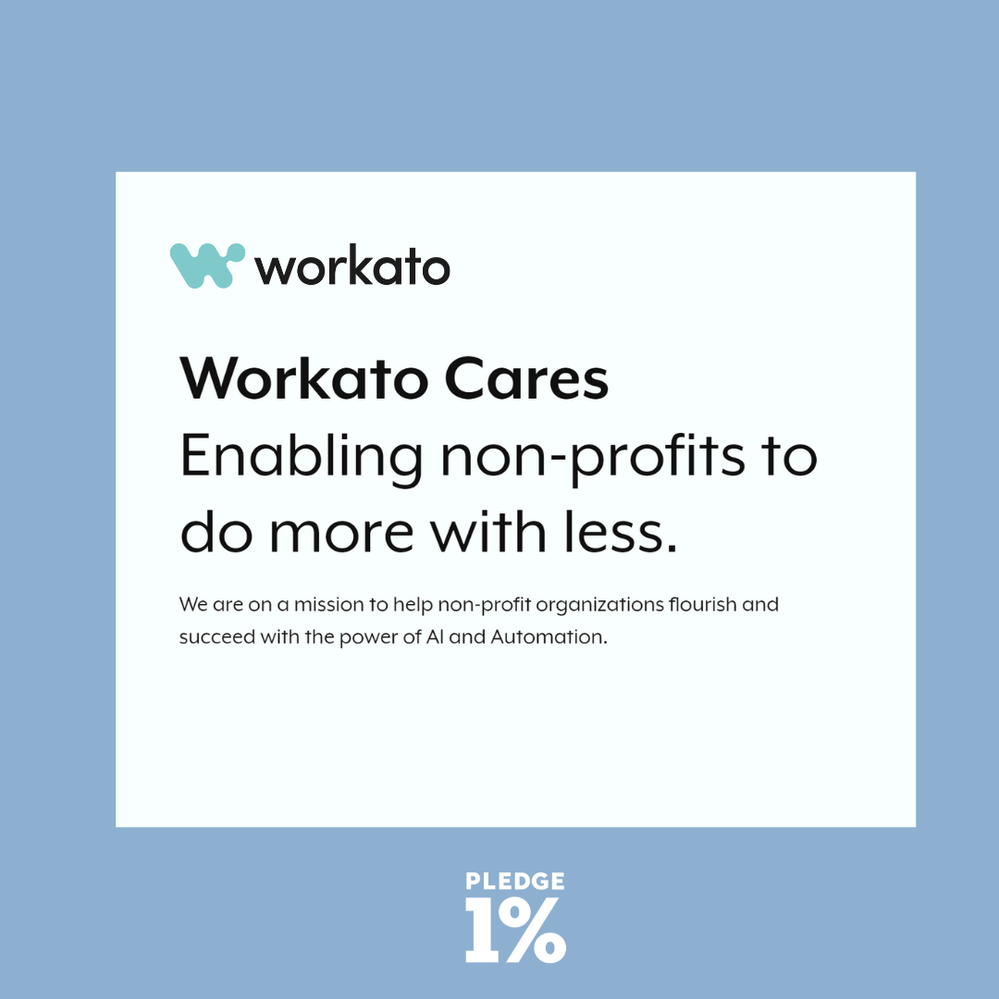
Original link
Author: Workato
MOUNTAIN VIEW, Calif.–(BUSINESS WIRE)–Workato®, the leading AI-driven enterprise orchestration platform, today announced the launch of Workato Cares, the company’s philanthropic initiative which aims to empower individuals with the knowledge, education, and tools to succeed and to enable nonprofit organizations to do more with less, powered by enterprise orchestration. As a part of Workato Cares, the company announced it has joined Pledge 1% and is committed to donating equity, product, and time for social good.
Workato Cares aims to give employees a sense of purpose, reinforce corporate culture and responsibility, and provide ongoing opportunities for connection and collaboration. The mission of this initiative is to be a force for good and empower people with technology, giving them the ability to build, make an impact, and change their lives. Workato’s co-founder and CEO, Vijay Tella, has been committed to giving back since founding the company in 2013, working with several nonprofits early in the company’s inception.
As part of Workato Cares, the company is launching its “MillionFold Impact” project where the company is targeting to reach the goals below within the next 10 years:
-
- 1 million people helped through Workato employees in partnerships with nonprofits and NGOs
- $10 million in product donations to nonprofit organizations
- $100 million in cost savings for nonprofit organizations using Workato
“As leaders, we have an obligation to give back to our communities to help create a better future. Everyone at Workato can drive positive change and lasting impact where it counts,” said Vijay Tella, co-founder, and CEO at Workato. “With Workato Cares, we’re committing our time, resources, and product to help create a more equitable and thriving future. We are fortunate that Workato is at a stage where we can dedicate resources to support corporate philanthropy as an integral part of our business and values. I am proud of this initiative and cannot wait to join my fellow team members in serving our community.”
Workato has also joined Pledge 1%, a global movement to create a new normal for companies of all sizes and stages to have a positive social impact through their business. Workato is joining over 18,000 companies worldwide who have committed to Pledge 1% of their product, profit, equity, or staff time to their chosen cause. Workato is proud to join the Pledge 1% community and encourages other companies to take the pledge and leverage their business as a force for good.
“It was clear from the beginning that community and service are pillars of Workato’s founding principles. Workato leads with their products and platform but at the core of what they do, they are dedicated to changing communities and having a lasting impact through their Pledge 1% commitment,” said Jan D’Alessandro, Pledge 1% ‘s Chief Legal & Philanthropy Officer. “We are incredibly excited to welcome Workato to the Pledge 1% global movement, and look forward to seeing what the future holds.”
Named a Leader in the 2024 Gartner® Magic Quadrant™ for iPaaS, Workato enables enterprises to transform their business operations by orchestrating business processes end-to-end and operationalizing AI across the entire organization. Designed with best-in-class security and governance, scalability, performance, and availability, Workato’s low-code, no-code platform makes it easy for IT and business teams to orchestrate their applications, data, and experiences.
To learn more about Workato Cares, visit here.
About Workato
The leader in AI-driven enterprise orchestration, Workato helps organizations drive business efficiency at scale without compromising security and governance. Built for Business and IT users, Workato is trusted by over 2,000 top brands, including Broadcom, Zendesk, and Atlassian. Headquartered in Mountain View, Calif., Workato is backed by Altimeter Capital, Battery Ventures, Insight Venture Partners, Storm Ventures, Norwest Venture Partners, and Redpoint Ventures. For more information, visit workato.com or connect with us on social media:
-
- Blog: https://www.workato.com/the-connector/
- Product Hub: https://www.workato.com/product-hub/
- LinkedIn: https://www.linkedin.com/company/workato
- Twitter/X: https://twitter.com/workato
About Pledge 1%
Pledge 1% is leading a global movement to embed social impact into all businesses. Providing a simple, flexible framework for setting aside staff time, product, profit, and/or equity, Pledge 1% encourages and empowers companies of all sizes to leverage their assets for good.
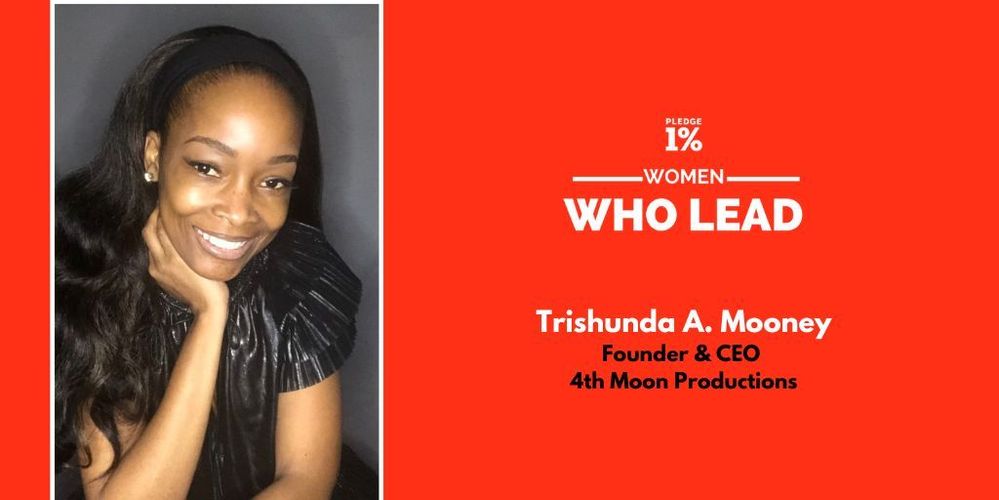
Trishunda A. Mooney
Founder/CEO, 4th Moon Productions
Alpharetta, USA
If you could describe yourself in one word, what would that be and why?
Hopeful! Growing up in rural Alabama, just below the poverty line, the 4th child of six, who was diagnosed at three years old with the most severe form of sickle cell disease (SS), I’ve strongly leaned on hope to keep moving.
My parents did a great job doing all they could to provide for us in so many ways. They embedded within each of us the importance of family and thinking outside of the box. Though we were not given everything we asked for, I remained hopeful they would find a way to deliver something even better and they never let me down. When I was diagnosed with this blood disorder, my parents also received the news that I was not expected to live beyond eight years old.
As far back as I can remember, I’ve turned to the hope of tomorrow, the next moment, the next year of achieving even more than what was being presented to me at the time. If I saw something that was contrary to what I was experiencing, I was hopeful I would too have the opportunity to show myself how my life is not limited to my circumstances.
Pledge 1% provides a framework for businesses to do good. Do you think it’s important for today’s corporate leaders to prioritize social impact? If so, why?
100%! There is something we are all passionate about, something we’ve all uniquely gone through that we could lend our voices and platform to bring awareness and education. In doing so, we bridge gaps in humanity…helping others who are currently experiencing something you’ve been through feel as though they are not alone. And even more so, you are an example of that circumstance not dictating your entire life.
Do you give back to the community with your team and work? If so, what does this look like?
Yes we do. Currently, 4th Moon Productions is producing an animated short film to bring awareness and education in support of the sickle cell community worldwide. Though the subject matter embedded within this project is sickle cell disease (SCD), we are determined to share it in a way that anyone diagnosed with any sickness, disease, and/or disability will find themselves in the story and be inspired to live beyond.

As the leader of 4th Moon Productions and producer of this project I feel more education and awareness is needed in support of bridging that gap where others with SCD, those fighting to make healthcare less discriminatory and accessible, family members and caregivers providing day-to-day care, or parents receiving the news of their child(ren) diagnosis feel the topic of sickle cell disease is apart of the conversations for change socially, politically, economically and globally.
What’s the best piece of advice you’ve ever received?
It is as you believe.
This year’s International Women’s Day themes are focused on investing in women and inspiring inclusion. What can we do to make today’s workplaces more equitable and inclusive for women?
First, understand how bringing “women” to the table of discussion about change is already inclusive. But to further that notion, “women” is made up of some uniquely talented, skillful, wise, strong, loving, passionate, diverse human beings who are all different in their own way.
Today’s workplaces should focus on each woman they have on the their team and meet them where they are. All women are not the same just as all men are not the same. Workplaces should begin implementing the flexibility of a more person-centered work environment where each team member feels heard, respected, and appreciated for their contributions to the goal(s) of the company without compromising the overall value of the company’s mission and vision.
What advice do you have for women who are just starting their career?
Move in your purpose. We were all created to leave something for the next generation…so, move in it. Everyday, in all you do…be the light and don’t be afraid to shine!
Move in your purpose.
What are you looking forward to this year? Are there any goals (personal or professional), activities, or experiences you are excited about?
Forever hopeful! Personal goals, getting married and having a child. Professional goals, producing my first animated short film and globally bring the sickle cell disease community to the table of discussions and change.

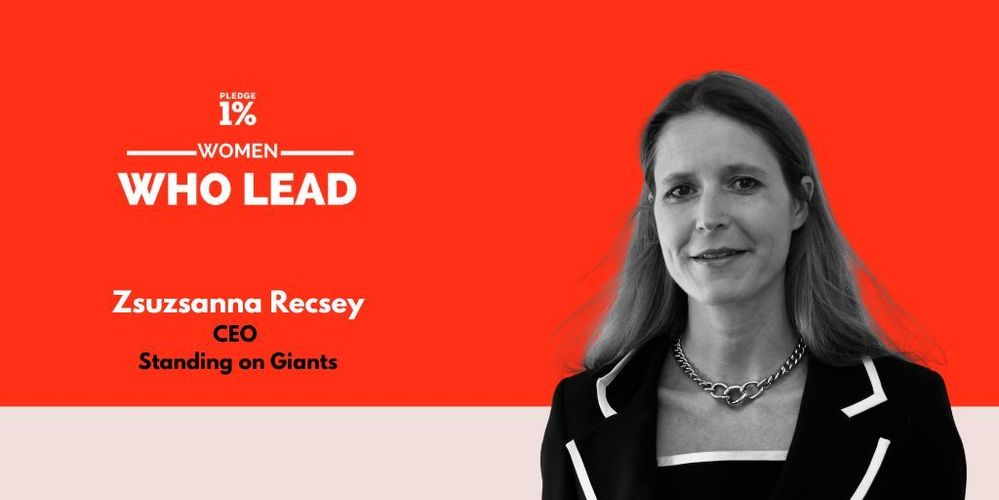
Zsuzsanna Recsey
CEO, Standing on Giants
London, UK
If you could describe yourself in one word, what would that be and why?
If I had to describe myself in one word that would be related to coaching and it most probably would be “Empowering.”
To me, coaching is fundamentally about helping individuals reach their potential and enhance their performance on their own terms. This involves facilitating their learning process, rather than merely teaching them. The most gratifying moments for me are witnessing those breakthroughs where individuals realise something pivotal, quite often sparking profound change. As a certified coach, I’ve had the privilege of facilitating these discoveries with my clients. Moreover, as a leader, I integrate this empowering approach into my daily business interactions, fostering a learning and growth environment.
Pledge 1% provides a framework for businesses to do good. Do you think it’s important for today’s corporate leaders to prioritize social impact? If so, why?
The real question isn’t whether corporate leaders should prioritize social impact, but why they wouldn’t. Our latest B Corp recertification, which saw a 14-point improvement even as our business significantly expanded, demonstrates how combining social impact with business success is not just feasible but also advantageous. Emphasizing People, Planet, and Profit together proves to be not only possible but genuinely rewarding.
During a team discussion about a client’s shift to complex scoring models for measuring objectives, I asked the team how they felt about this challenging change, half-expecting frustration. However, a community engagement manager shared a perspective that truly embodies our ethos. Despite her lack of full understanding of the new system, she was unwavering in her commitment. “I will continue to prioritize our members, focusing on meaningful engagement. The metrics will align as a result of our genuine efforts,” she stated. The team’s full endorsement of her viewpoint was both affirming and inspiring.
Do you give back to the community with your team and work? If so, what does this look like?
We are fortunate to have the opportunity to build and nurture communities through our core business activities, where we assist companies in engaging with their customers in meaningful ways. In addition to this, we are committed to making a positive impact by providing financial support to carefully selected causes on a consistent and structured basis. A portion of the fees from our largest financial transactions is dedicated to chosen charities (through a B Corp partner).
Our efforts are also tailored to support issues that resonate with our diverse team and areas where we believe our unique skills can have the greatest effect.
For instance, in response to the crisis in Ukraine, our contribution extended beyond merely collecting and matching donations to charities aiding refugees. Leveraging the rich linguistic capabilities within our team, we were offering translation services during work hours, as part of an official program, to further support the cause. This initiative is a good example how we can utilize our specific talents for a significant impact.
What’s the best piece of advice you’ve ever received?
The best advice I’ve ever received unfolded around the dinner table, where two of my father’s friends shared differing views on my next steps: pursuing a Master’s degree after my Bachelor’s or starting my career immediately. I chose further education, a decision my parents wholeheartedly supported. This path wasn’t just about accumulating knowledge; it was an investment in my future. Through additional degrees and various qualifications, I gained not only expertise but also invaluable experiences and opportunities that lead to a rewarding and successful career.
This year’s International Women’s Day themes are focused on investing in women and inspiring inclusion. What can we do to make today’s workplaces more equitable and inclusive for women?
I would pick two initiatives, through which companies can make the workplace more welcoming and supportive for women of all ages.
Flexible work and support for younger women. Understanding that younger women often balance work with caregiving or parenting, it’s important to offer flexible work options like remote work, flexible hours, or part-time roles. Additionally, creating supportive policies is crucial. This means things like longer parental leave, help with childcare, and options for emergency situations. For instance, a company could help cover some childcare costs or work with local childcare centers to offer discounts to employees.
Support for women experiencing menopause. For employees going through menopause, being able to work flexibly is really helpful. But there’s more that can be done, like educating everyone in the workplace about menopause. This includes teaching male employees and managers what menopause is about so they can be more understanding.
Workshops or information sessions can be set up to share knowledge about menopause and how it affects women, along with ways to support colleagues going through it. Creating an environment where everyone knows and respects what women experiencing menopause are going through makes the workplace better for everyone.
What advice do you have for women who are just starting their career?
Surround yourself with mentors, sponsors, and peers who encourage and guide you. Look for role models who inspire you and can offer practical advice from their experiences.
Learn to advocate for yourself; whether it’s negotiating your salary, asking for a promotion, or seeking opportunities for growth. Understand your worth and don’t shy away from pursuing what you deserve. And one more, as you climb the career ladder, don’t forget to support other women along their journey.
Understand your worth and don’t shy away from pursuing what you deserve.
What are you looking forward to this year? Are there any goals (personal or professional), activities, or experiences you are excited about?
I’m excited about wrapping up our strategic plan that aligns with our core purpose for the upcoming three years, especially after successfully achieving the goals of our previous three-year plan, which included both business and social impacts.
Looking ahead, we aim to continue our sustainable growth and broaden our social impact to reach even more stakeholders. At the same time, we’re focused on enhancing employee participation in decision-making and shaping the future direction of our company.
On a personal note, one of the highlights for me this year will be attending some of the events at the Paris Olympics with my son.
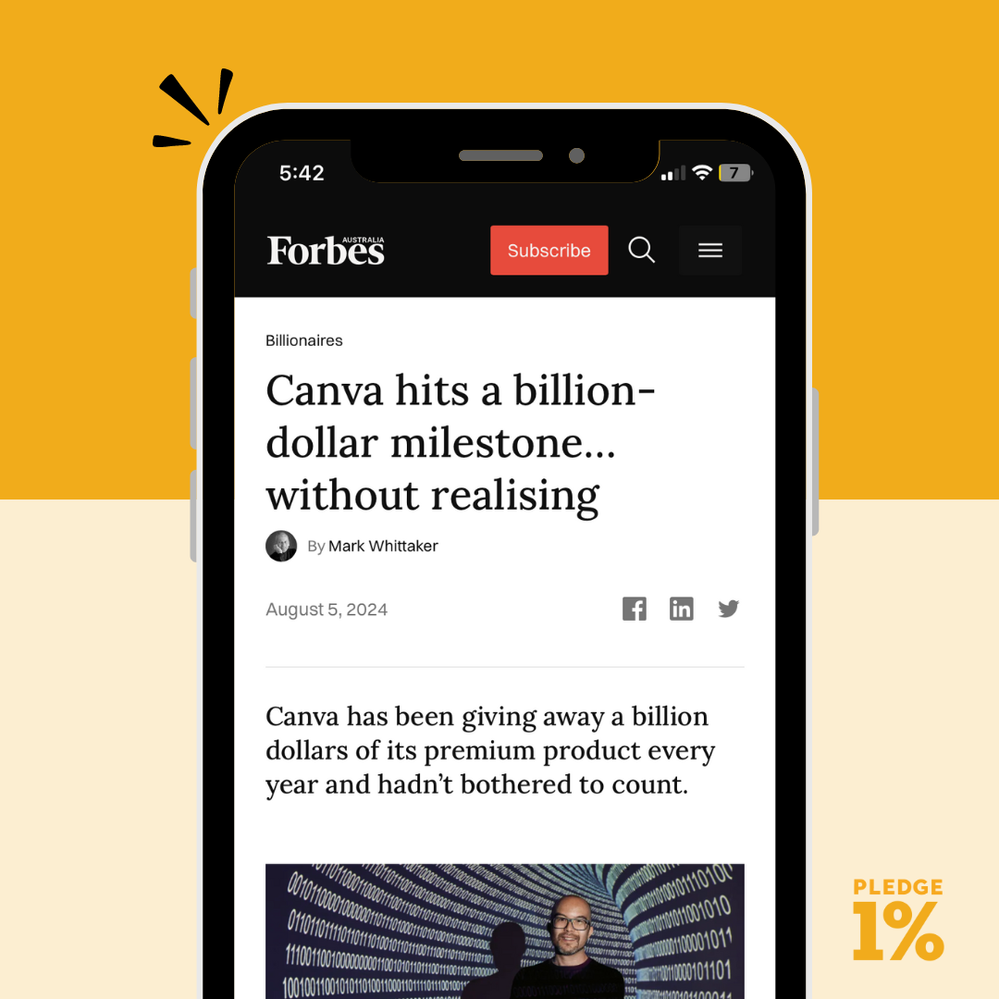
Original article here
Author: Mark Whittaker
Canva has hit so many billion-dollar milestones that it’s easy to lose track. Co-founder Cam Adams said the design juggernaut made it’s premium product free to non-profits in 2015 – reaching some 650,000 organisations – and to schools in 2019.
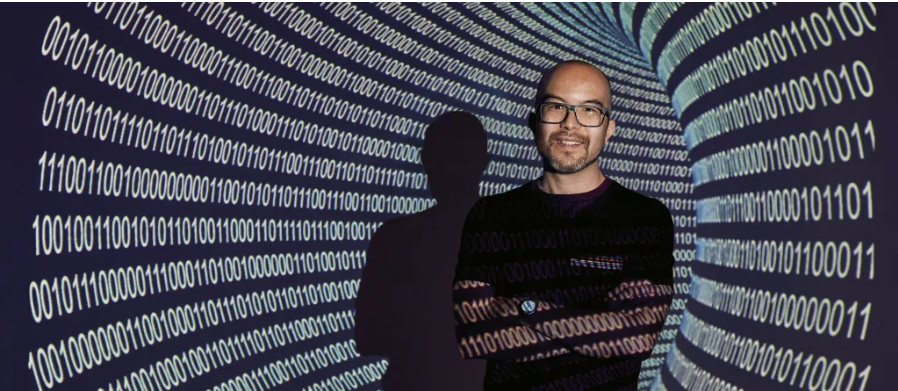
Canva co-founder Cameron Adams. Image: Forbes Australia
Forty million students have jumped on since it launched a “classroom safe” AI last October, Canva says, bringing the number of students and teachers using the premium product for free to 70 million, at 750,000 schools.
All of which got the Canva leaders wondering how much they were giving away, Adams tells Forbes Australia.
“So we ran the numbers, and we’d just hit the $1-billion mark, which means that every single year we are now giving away the equivalent of a billion dollars of revenue to educators and to non-profits.”
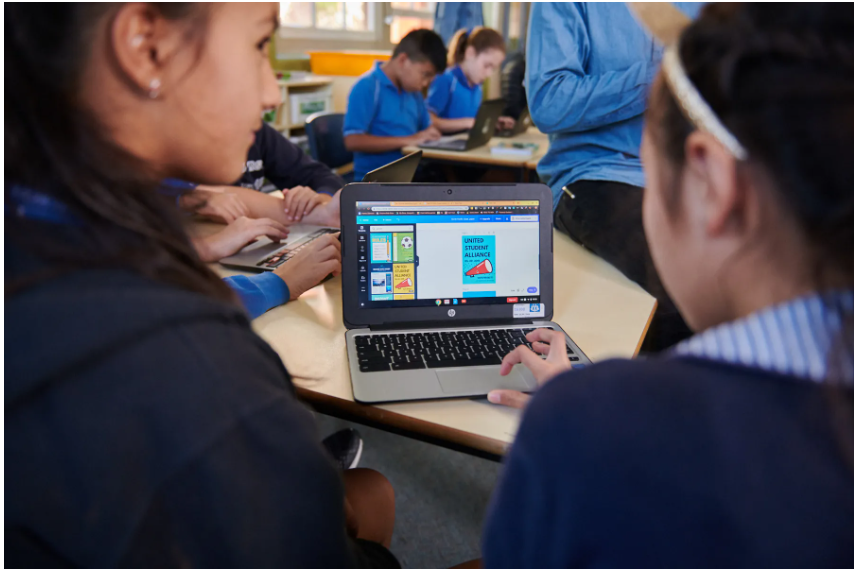
With Canva last valued at $40 billion – and continuing on an acquisitive path, recently taking over Leonardo.ai – the three Canva founders have made a thing about progressively giving away their wealth.
In 2019, the private company joined Pledge 1% – founded by Salesforce, Atlassian and Rally – with the goal of companies giving 1% of their equity, 1% of product, 1% of profit and 1% of employee time to charity.
Canva’s last reported annualised revenue was $2.7 billion. So if you add the $1 billion given away, then turn it into a percentage, it equates to Canva giving away 27% of revenue.
Adams wants more companies to join the pledge.
“One of the great things about Pledge 1% is it’s relatively easy to do,” says Adams. “One per cent is a small number in the scheme of things, but it introduces you to doing good and philanthropy, and inevitably encourages you to do more. Obviously, giving away a billion dollars in equivalent revenue every year is more than 1%, but we’re happy to go above and beyond.”
Two years after pledging that 1%, Adams’s co-founders Melanie Perkins and Cliff Obrecht promised to give 30% of their equity in the company – the married couple’s share being an estimated $13.2 billion, combined – to their charity, the Canva Foundation.
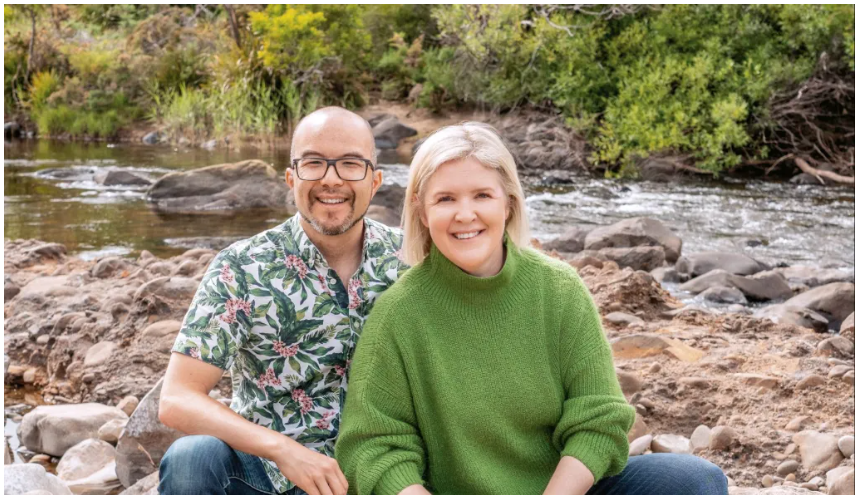
Wedgetail founders Cameron Adams and Lisa Miller.
Adams has not joined them in that promise, but says he and wife Lisa are intending to do something similar with their estimated $3.37 billion fortune, devoting it to their biodiversity-focused venture-fund and loan facility Wedgetail. “We’re just waiting for all the pieces to line up in terms of having a registered non-profit and stuff like that,” he says.
Adams can’t remember when he and his co-founders started talking about giving so much away. “There was just a kind of a values alignment from the early days. It even stems from the business model. We always wanted a free product that we could give to everyone in the world. We wanted people to be able to access design and use these new visual communication skills to achieve amazing things.”
And while OpenAI’s billionaire cofounder and CEO Sam Altman has given away US$45 million in monthly gifts to individual Texans in order to study a “universal basic income”, the Canva Foundation has been conducting a similar experiment in one of the world’s poorest countries.
It gave $10 million, then $20 million, to GiveDirectly, a charity which eschews traditional aid routes to give money directly to the impoverished. “The whole philosophy behind it is that it’s not about building a school or building a well for a community, it’s about giving people the money that they need to solve their own problems. They know best what is going to help them.

OpenAI Co-Founder & CEO Sam Altman.
And while he applauds Altman’s efforts to make a better world with universal basic income, he says it’s only tangentially related to what the Canva Foundation is doing. “Our work is really focused on the areas of the world where the need is most extreme.”
GiveDirectly identifies an impoverished community and gives thousands of people regular grants totalling between US$250 and US$750 over several months. “The overwhelming evidence coming back is that when you do this, as opposed to, like, building your own infrastructure program, it has greater positive impact,” says Adams.
“You see people starting businesses which enable them to drive income over many years. You see people building houses that house their family. You see people buying goats which give them income. It creates this broader system of sustainable economic support that they need to get themselves out of poverty, as opposed to creating infrastructure projects that don’t get maintained and end up going nowhere.
“So we’ve delivered close to $30 million now into that project, and we’re monitoring it. GiveDirectly is working a lot on the ground, and the plan is to scale that up successfully throughout this year, and the years beyond, and that will scale through Malawi and then eventually scales throughout the world.”
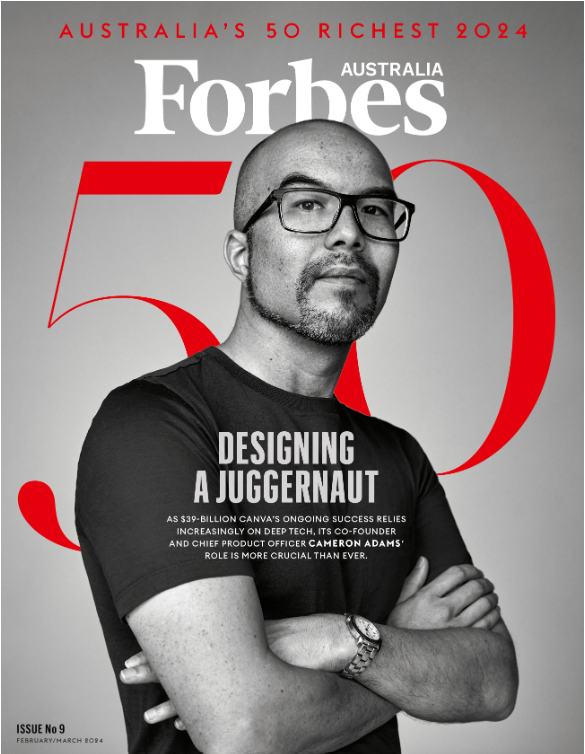
Cameron Adams on the cover of Issue 9 of Forbes Australia.
Blackboards to onboarding
The Canva founders started looking at education uses in 2017. “But it was in 2019 when I really picked up the baton, because we started noticing a whole bunch of teachers and students using Canva,” says Adams. “And we didn’t originally design Canva for education … So we started looking at what teachers and students were using it for, started thinking about how we might improve the product to be able to make it better for them … I went to the States. We interviewed a bunch of education users there … as well as school districts and even at the level of ministries of education, what they would all need. And we started putting together what became Canva for Education.”
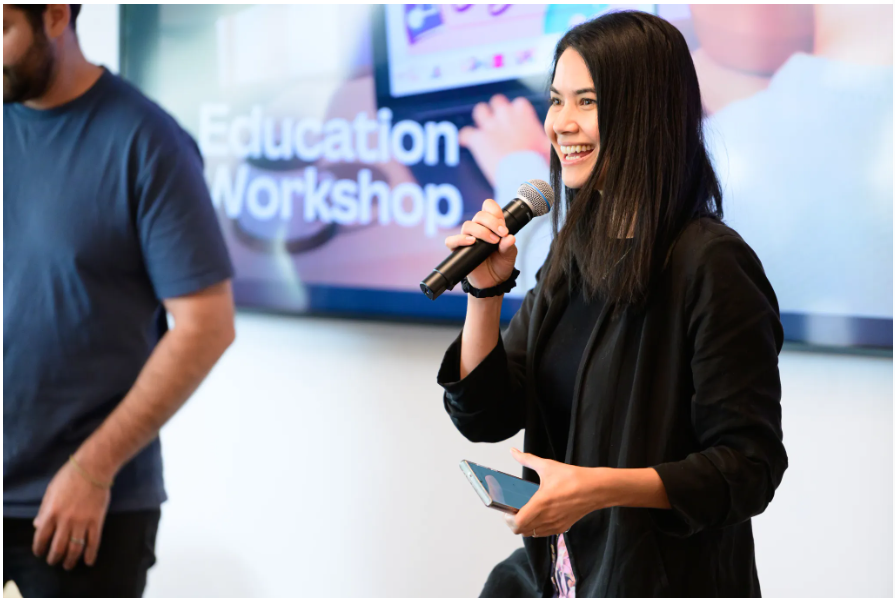
Canva co-cofounder Melanie Perkins. | Images: Supplied
Adams doesn’t resile from the cynical view that Canva for Education is just onboarding the next generation of paying customers.
“That’s part of the social impact as well. We’re helping every student develop design skills, develop digital literacy and also spark creative thinking. And by developing those skills, we’re really fueling the next generation of change makers, like people who are going to start new businesses, new non-profits, drive movements to help solve climate change, help solve many of the world’s problems – and make sure that there is a new wave of Canvas wanting to leave the world in a better place than they started with.”
It didn’t cost much, he says. “By just flipping a switch behind the scenes to give them access to a free product, it’s probably one of the highest leverage things that we can do.
“We’re seeing not only whole school districts now pick it up, we’re seeing entire countries as well. So Indonesia just rolled out Canva for Education. Poland too. And, equally, we encourage any non-profit anywhere in the world to get in touch. We’re really keen to grow that program beyond a million non-profits using Canva over the next year or two.”
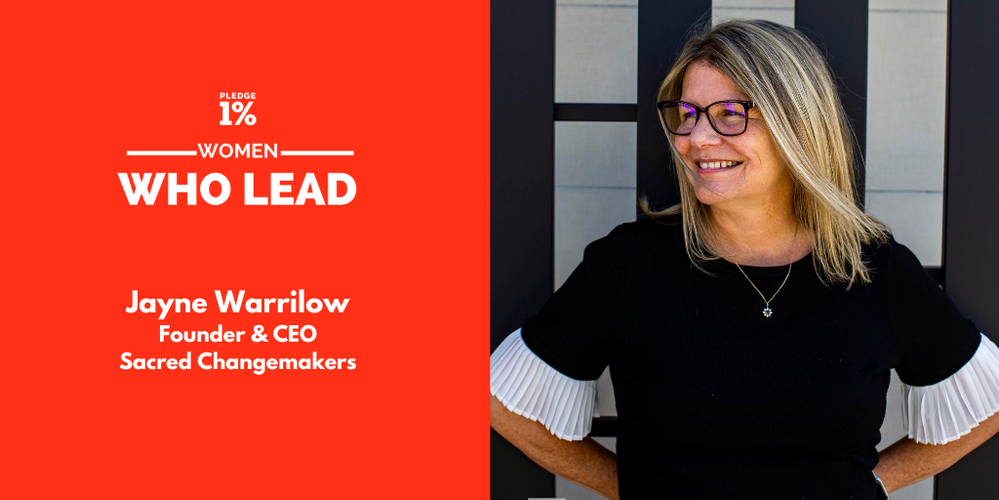
Jayne Warrilow
Founder & CEO, Sacred Changemakers
Columbus, Ohio
If you could describe yourself in one word, what would that be and why?
Curious – I don’t settle for the way things are and am always looking to evolve and improve, I tend to disrupt the status quo.
Pledge 1% provides a framework for businesses to do good. Do you think it’s important for today’s corporate leaders to prioritize social impact? If so, why?
Yes. This is key to my work at Sacred Changemakers, after working a consultant/coach for over 30 years I realized my impact has been to make a lot of white people even richer, that had to change.
Business is the biggest lever for change we have, we must shift our perspective beyond profit. This is my legacy work, I’m dedicating the rest of my career to this message.
Do you give back to the community with your team and work? If so, what does this look like?
Yes, we partner with B1G1 to support many projects worldwide aligned with the UN SDG’s. We also support Pachamama Alliance and last year I travelled to Ecuador to live with 2 different Indigenous Nations to see first hand the damage being done to the Amazon Rainforest. It was life changing and has doubled our efforts to helping more business leaders understand the problems and helping them to make changes, beyond merely having a CSR department – over there and not integrated into the organizational culture.

What’s the best piece of advice you’ve ever received?
“The people who are the hardest to love are the ones who need it most.” This is a great reminder when doing this work and coming up against sexism and bias in my work. It’s helped me so much over the years to stay compassionate when powerful men especially, can be so rude!
“The people who are the hardest to love are the ones who need it most.”
This year’s International Women’s Day themes are focused on investing in women and inspiring inclusion. What can we do to make today’s workplaces more equitable and inclusive for women?
Continue shattering the glass ceiling. Dismantle the patriarchy. Create equality. We are still so far away from where we need to be. Raise awareness and change culture one conversation at a time.
What advice do you have for women who are just starting their career?
Do your own inner work to find your true purpose. Get to know yourself first. Then find a career and organization where you can express what matters most to you fully. If you find yourself in a job where you can’t bring yourself to work, for whatever reason, leave – your health and wellbeing are more important than you might think.
In your 20s take jobs that give you the experience you need to be ready for an amazing role in your 30s forget about the money…
What are you looking forward to this year? Are there any goals (personal or professional), activities, or experiences you are excited about?
We redesigning and evolving our podcast and community to bring even more value to our Sacred Changemakers. We’re also investigating B-Corp status and considering running our own conference in 2025 to lead the conversation that matters most.
Carol Ganz
VP of Client Success, Six Feet Up
Fishers, United States
If you could describe yourself in one word, what would that be and why?
In one word, I am persistent. This quality has been crucial in my journey from entering the tech world 15 years ago to leading client success at Six Feet Up. Our company’s 25-year history of strong, respectful partnerships reflects this persistence. I believe in bringing out the best in our team and clients, creating an environment where everyone feels valued and heard. This has helped build lasting relationships and a supportive, diverse workplace.
My commitment extends beyond work, influencing community involvement and family life, underscoring the importance of persistence in every aspect of life.
Pledge 1% provides a framework for businesses to do good. Do you think it’s important for today’s corporate leaders to prioritize social impact? If so, why?
Prioritizing social impact is imperative. It’s about creating a sustainable world and a work culture driven by purpose. Specifically, Six Feet Up is committed to completing projects that not only advance technology but significantly benefit humanity.
By committing to social impact, companies not only contribute to societal betterment but also inspire innovation and loyalty among employees.
Do you give back to the community with your team and work? If so, what does this look like?
Giving back is woven into the fabric of Six Feet Up’s culture. We aim to inspire others by collaborating with like-minded companies on projects that impact the world.
Our 10-year goal has been to complete 10 IMPACTFUL Projects™ — defined as impressive, purposeful, and transformative — by 2025. As of today, Six Feet Up has had the privilege to work on 9 IMPACTFUL Projects™ ranging from space exploration to lightning strike predictions, forest fire management, genetic engineering, battery energy storage, agriculture data accessibility, and carbon emissions reduction. We are well on our way to achieving (and surpassing) this goal.
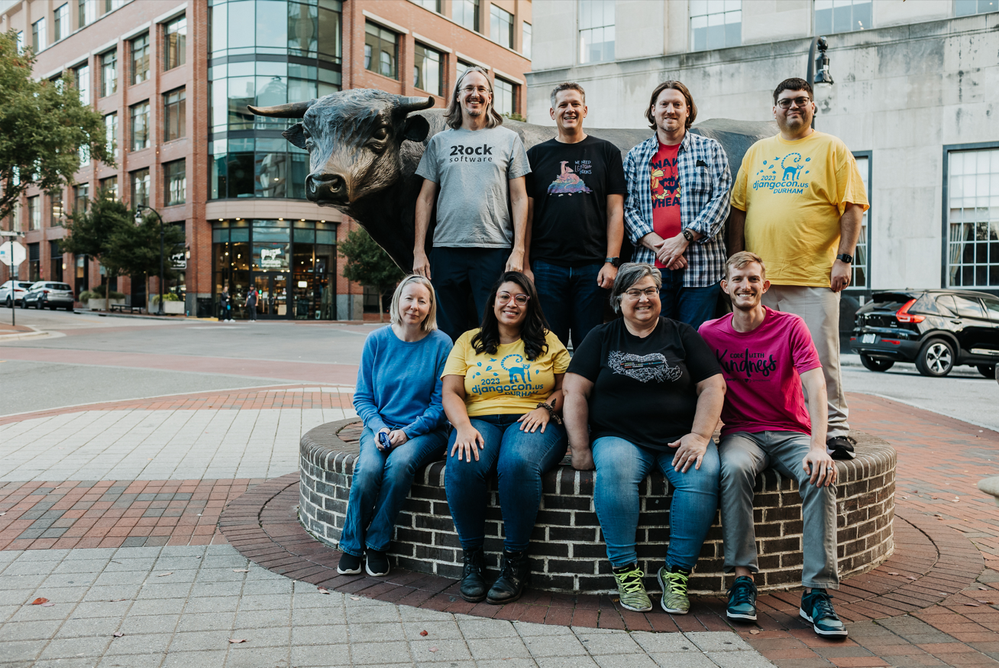
Additionally, joining the Pledge 1% movement and the company’s engagement with the open source community reflect its dedication to making a positive impact beyond the realm of technology. For the past decade, I have served on the board for various non-profit organizations including the Plone Foundation, Django Events Foundation North America (DEFNA) and Women & High Tech. These roles allow me not just to contribute but also to witness firsthand the transformative power of collaborative efforts in technology and diversity.
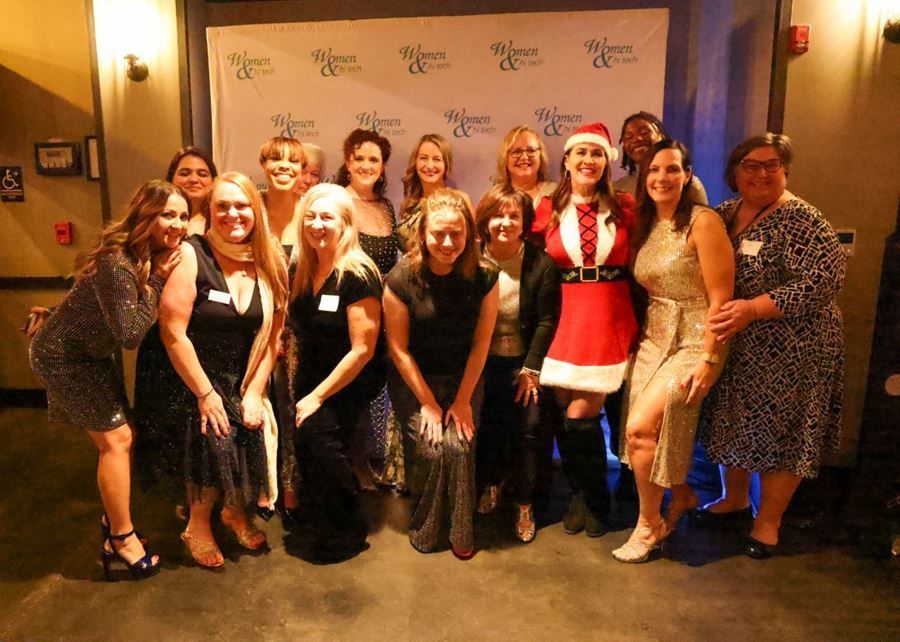
What’s the best piece of advice you’ve ever received?
“Be yourself and embrace your unique skills.” This piece of advice has been a beacon throughout my career. At Six Feet Up, we encourage each team member to embrace their inherent strengths. This philosophy has not only fostered a diverse and inclusive environment but has also been instrumental in our ability to innovate and meet the complex needs of our clients with authenticity and precision.
“Be yourself and embrace your unique skills.”
This year’s International Women’s Day themes are focused on investing in women and inspiring inclusion. What can we do to make today’s workplaces more equitable and inclusive for women?
Making today’s workplaces more equitable and inclusive requires active and intentional efforts. Organizations must actively listen to and amplify women’s voices, ensuring their representation in leadership roles and decision-making processes.
At Six Feet Up, a woman-owned software company that values a blend of emotional and intellectual intelligence, we strive to ensure that every voice is heard and valued. Personally, as the mother of a trans son, I deeply understand the importance of equity and inclusion. The journey for equality doesn’t stop with us; industry-wide, we must normalize mentorship, challenge conventional hiring practices, and foster environments where women, and all employees, feel empowered to contribute and excel.
What advice do you have for women who are just starting their career?
To women embarking on their careers: Seek out mentors, never hesitate to ask questions, and boldly pursue opportunities, even if you don’t meet every listed requirement.
Embrace your unique perspectives and experiences—they are invaluable assets. At Six Feet Up, we believe that diverse viewpoints fuel innovation. We actively support this through active involvement in organizations like Women & High Tech which exists to change the landscape of women represented in science, technology, engineering, and math (STEM) to be equally inclusive to all.
What are you looking forward to this year? Are there any goals (personal or professional), activities, or experiences you are excited about?
This year is poised to be a landmark for Six Feet Up which celebrates its 25th anniversary in 2024. Professionally, I’m excited about achieving our goal of completing 10 IMPACTFUL Projects™ by 2025 and setting new benchmarks — like contributing to 100 IMPACTFUL Projects™ by 2033.
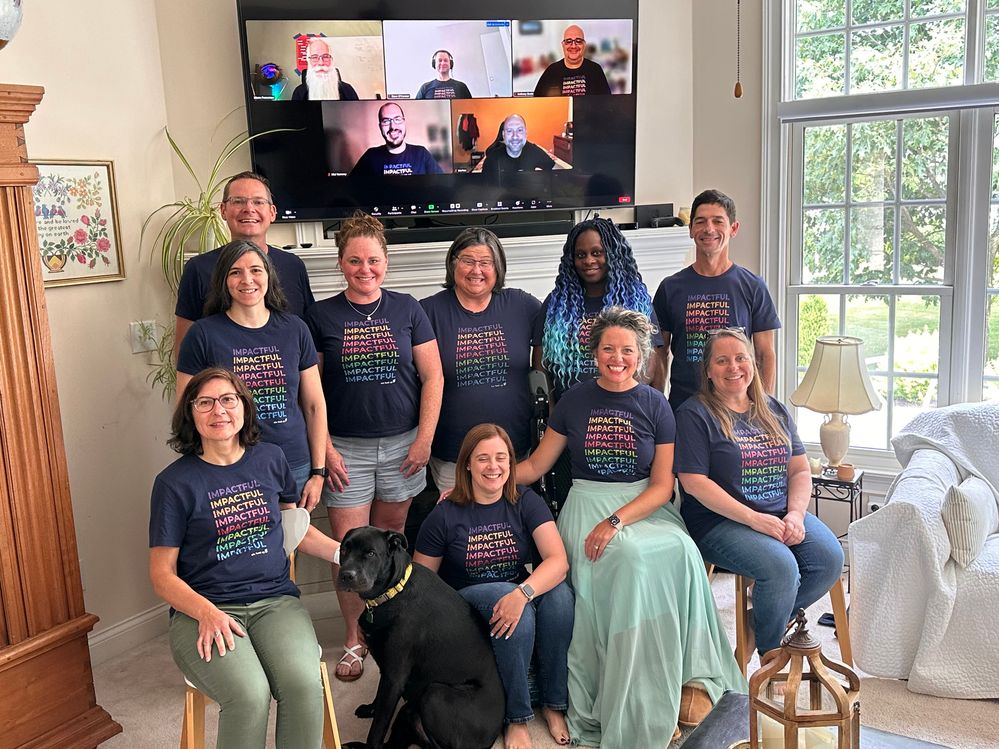
I’m also excited about Six Feet Up’s broader industry recognition as a top Innovation Service Partner of the Year at the Mira Awards, the Oscars of Tech in Indiana.
On a personal level, I am focused on nurturing our client relationships, driving our mission forward, and supporting my team in their growth and success. Beyond professional goals, I am committed to finding a healthier work-life balance, learning to ‘switch off’ and investing time in personal well-being and family.
